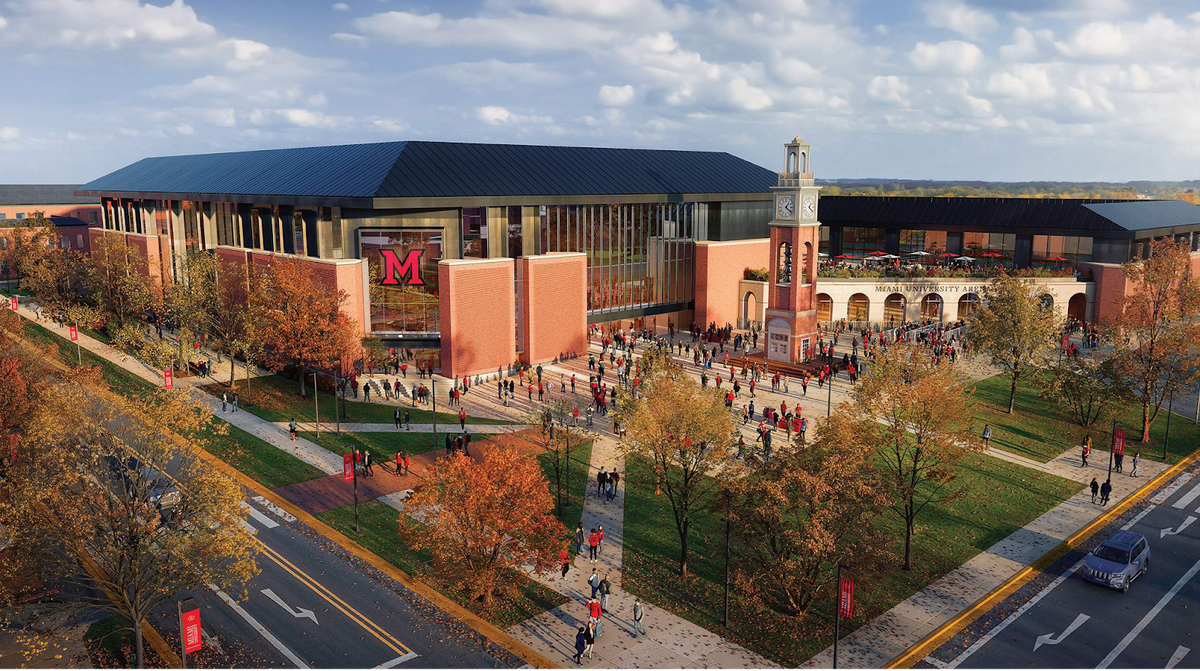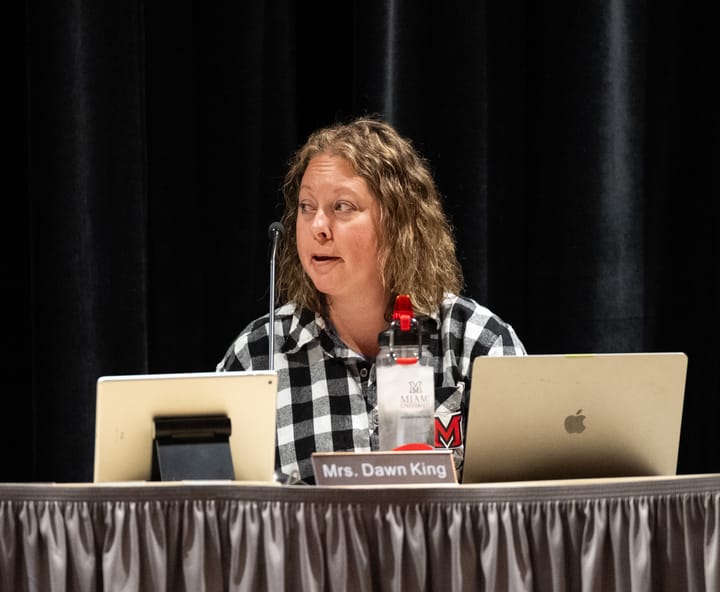What we know about Miami’s ‘Event District’ so far
Miami University is planning an “Event District” on a campus green space.

Miami University is planning an “Event District” on a campus green space.
Since a site selection committee recommended in February for the university to construct an arena replacing Millett Hall on Cook Field, little information about the project has been made concrete, and many opinions have been shared from the campus community.
As the fall 2025 semester begins, here’s what we know about the project so far.
‘Exploratory phase’
Ande Durojaiye, vice president for strategy and partnerships, said the idea for the Event District came from conversations about a new arena which would support the university’s basketball and volleyball programs while accommodating other events that could be hosted in the space.
As of now, Durojaiye said the university is still in its “discovery phase” of how to approach the project, although a location has been chosen and the university has discussed what it wants as part of the district.
“We’re hoping that if we get the green light to move forward with the new arena, we not only get a new arena, but we also look at hotels, restaurants and other areas of hospitality that will support a larger event,” Durojaiye said.
“Because one of the things that we see is this is not only about the university … but also Butler County to really take advantage of the opportunities the state of the art arena can bring to this region of Southwest Ohio.”
Durojaiye used the Spooky Nook Sports complex as an example of a space which he said has “really transformed and had a big economic boost within Hamilton.”
“And we see an arena here and this new Event District also having a similar economic boost within Oxford, as well,” he said.
Still, Durojaiye said the university has not completed an economic impact study for the project, as it is still in the “exploratory phase.”
He also could not provide a clear timeline for the project.
Durojaiye said the cost of the new arena and event space is not clear yet, although “we know that a new facility would cost us probably in the range of $180 million.” He said this cost would need to be “balanced” with deferred maintenance costs on Millett Hall.
“One of the things that you know it’s always going to be contingent upon is cost,” he said. “So that’s something we’re actively evaluating.”
Durojaiye said, as the project is being explored, he couldn’t clarify what’s a “for sure thing” or not, but the university is determining whether its budget can support a new arena.
The project currently appears on the university’s website as part of its MiamiTHRIVE Strategic Plan.
“As far as sure things, we’re actively engaged. We are looking forward, if the dollars align the way we’d like them to align, we’d be excited about moving forward with the project.”
When asked if the university has a particular focus on supporting its student athletes or a “vested interest,” Durojaiye said, “100% we have a vested interest in supporting our student athletes. Our student athletes continue to excel, in my opinion, the strongest overall athletic program in the MAC (Mid-American) Conference.”
In response to concerns about the university building on Cook Field, Durojaiye said, if the new arena is built, the university would be able to utilize the space where Millett Hall is as additional green space for the campus.
When asked if the university had reached out to faculty about the project, Durojaiye said, “We’ve had multiple conversations about this all over the last year, and so yes, we’ve engaged with our faculty about the opportunity.”
“I think it’s very responsive. We’ve got a lot of folks who are excited about the opportunity. We have other folks that might have questions about things at the campus. I can’t tell you how they responded. We got a lot of different responses,” he said.
Overall, he said, “I think we’re doing our due diligence to make sure that we’re making the right decision and we’re moving us in the right direction.”
Millett’s condition
Millett Hall, named after the university’s 16th president, was opened in 1968 and houses the men’s and women’s basketball and volleyball teams.
When the university reached out to Miami’s community via a survey, reporting from the Oxford Free Press showed 250 respondents explicitly said they preferred the idea of renovating Millett or putting the new arena in the parking lot or the front lawn to using Cook Field as a site for the event district.
One survey-taker, Maggie Storts, said her great-grandfather is John Millett, calling it a “physical manifestation of the impact that John Millett had on campus.”
According to a university announcement from February, the university wrote it would spend $13 million to relocate the recreational fields to the area in front of Millett Hall. The university said in the announcement, Miami also plans to work with the Student Government to design the new recreational fields.
But Abby Howell, a junior at Miami who wrote an opinion piece about Cook Field for The Miami Student, told the Oxford Free Press, since Millett is farther away from the center of campus – a 20 minute walk for her – she believes students are less likely to use that space in between classes.
As a freshman, Howell said she participated in intramural soccer tournaments, which were hosted on Cook Field – a five to seven minute walk from her dormitory.
“I could just go in between, get my homework done and then get on my cleats and just walk over there and play for a bit, and it’s just a really nice sense of community to be there,” Howell said. “And I think that would have been a much bigger commitment if I had to get all my bags and hike up to Millett to do it.”
She said she still thinks Millett would be a better spot for the Event District.
Jack Davis, a senior at Miami who’s the president of the club baseball team, said his teammates use the field for tryouts and practice. He said, although placing a new recreational field in place of Millett would “make up for it almost,” several members of the team are freshmen who don’t have a vehicle.
“Cook (Field) is essential in that aspect for our team,” he said.
Still, he thought the new Event District could “bring back the school spirit” and a “sense of rallying around a sports team, which we haven’t had in a while.”
When asked for ideas for alternative locations for the Event District, Davis said, “Why not build around Millett? It’s already there.”
Since 2024, Miami has been drilling 520 geothermal wells 850 feet deep beneath the surface of Millett’s front lawn, according to the university’s website. The project, which was set to be completed by next year, is part of the university’s goal to become carbon neutral by 2040.
Durojaiye said it's not clear what the building implications are of the geothermal wells being beneath the surface, although the university would need to take them into account for any renovations to Millett.
During a December Board of Trustees meeting, The Oxford Free Press reported a university administrator estimated the cost of renovating Millett to be around $80 million.
Adam Beissel, an associate professor and researcher in the department of sport leadership and management, called Millett “outdated, antiquated, and, quite simply, below the standards of what our athletic conference and more broadly what college athletics is really accustomed to.”
“That facility was built when there was only one athletic team on campus: basketball. Now there are three that need to share that facility. And so from an operational perspective, balancing three teams with one court, it's just incredibly difficult. The second is that one, it's massively outdated, and it’s arguably not ADA compliant,” he said.
Beissel said, not only would there be a base cost of an estimated $80 million to renovate the facility, but he remembered a discussion at a Board of Trustees meeting about it costing another several million to expand the facility to have sufficient space for all three teams.
The trade off, he said the university shared, with spending more money on a new facility, “was that it’s far more attractive to philanthropic donors and those who would give gifts if it were a brand new arena rather than a renovated Millett.”
“There’s the old adage that athletics is the front porch to the university. I don't know that. I personally have always agreed with that consensus,” Beissel said. “But as someone who recruits students routinely and regularly at Miami, you know we like to take them to nice facilities. … You better believe that the minute that there is a new basketball arena … the place that students would get taken to, the place that they would have open houses, the places that they would have career fairs and graduation would be that arena.”
Beissel said, still, there’s not much evidence that having a stadium more central to town will have an impact on long-term attendance at games.
“I think that’s the million dollar question, right,” Beissel said. “The sort of mantra, ‘If you build it, they will come.’ … Whether or not it'll work is somewhat unclear, because we don't really have a whole lot of historical precedent of this on college campuses, even though we do, to some degree, within cities.”
Mixed opinions
When the site selection committee voted unanimously on Cook Field as the location for the Event District, students were not included in the process.
Despite reporting from the Oxford Free Press that a university survey with more than 1,500 respondents showed a wide opposition to the arena being placed on Cook Field, and a petition signed by 2,400 people called on Miami to preserve the field, Director of Communications Seth Baugess said the focus of the university would be to make the Event District a “student-centered project.”
Howell said, following the results of the survey, the decision of the site-selection committee “does not seem very student-based or student first or like we’re looking at the student opinions.”
Cathy Wagner, a professor and faculty-at-large on the university faculty senate, said not very much information has been formally shared with faculty.
“What I have known about it that has been formally shared (through) the university has been through The Miami Student and the Oxford Free Press. There’s been very little apart from the, some comments by the provost in senate and the CFO, David Creamer, talking about, more or less, rough reasons for doing it,” Wagner said.
Wagner said, after information was shared through the local press, the university seemed to try to “backpedal” to spread the word.
“On the one hand, I feel like this is how things go in the way that universities work right now. There’s a lack of transparency, there are decisions made at the top without consultation,” Wagner said. “But also, I feel like that’s not good, that ideally, especially students who are going to be using these facilities most would have some say.”
Overall, she said she “regrets” the loss of Cook Field and believes there might be a better place for the arena. Wagner also questioned whether investing in athletics, or having a better athletics program, would bring more attention and more donors to the school.
Beissel said, while there are opportunities for future improvements and expansion in athletics and events, “There are other needs.”
“I’m hopeful, and I’m maybe cautiously optimistic that they will design something that isn’t just, it isn’t only about athletics but caters to all students and all types of programming events that the campus community needs,” he said, adding students in his department, which caters to one out of every 16 students, could benefit from a larger facility in terms of having more opportunities for internships, but the arena could also be used to host graduations, open houses and job fairs.
Davis said, regardless of what happens with the project, “I just hope there’s a space for us to have practices and there’s a space for people to still get outside and play catch with baseball or football and exercise outside.”
Mayor Bill Snavely, who introduced a resolution to the Oxford City Council earlier this year asking Miami to let the city know when making a developmental decision like the Event District, said members of the treasurer’s and engineering office meet with city officials every month to keep each other informed.
Still, he said anything Miami wants to do on its campus is not controlled by the city, “So we view what they’re doing on Cook Field primarily as their business.”
He said he does have concerns about the traffic an Event District would bring and the impact it might have on city businesses if those in the Event District were competitive, although he said if it aids economic development or creates more excitement around university athletics, it could be a “good thing.”
He also had a concern about the height of the potential hotel, and if city fire trucks would be able to service it in an emergency.
But as a former Miami professor and long-time Oxford resident, Snavely said, “I've been here since 1977, and I've seen a lot of development on campus, and it is not uncommon for people to be resistant to change and to think that it is calamitous. And in fact, over time, I found that most of them are not so calamitous, and we get used to them and it's a new reality.”
Snavely said, “I don’t think that the location is going to have a big negative effect on the community, whether it’s at the Millett Hall location now or whether it’s on Cook Field.”
More questions
Wagner said the faculty senate passed a resolution in favor of the Campus Planning Committee creating a new campus plan which would include changes for spaces over the next several decades. She said the faculty senate also said the committee should be involved in discussions about the arena.
David Prytherch, a professor and member of the Campus Planning Committee, told the Oxford Free Press in an email he does not believe the administration has responded to the senate’s or the committee’s push for a Campus Master Plan.
“A task force was hand-picked to choose among a limited set of arena locations, but that accelerated process involved limited public engagement and was not guided by campus plans,” Prytherch said. “An Arena District involving a major athletic facility, hotel, and potential commercial development on Cook Field was not envisioned by any existing campus plans developed with community input, which have assumed Cook Field would remain campus open space.”
Prytherch said there are still a lot of “deep questions” about how the development would impact the campus and work as a physical facility but also from a budget and priority perspective as an "unprecedented investment” with a “huge risk.”
“Well I think that in part, the institution itself doesn’t have all the answers. I think that this is an idea, a presidential initiative, and I think there are questions about how much background information we have about what it would mean to do,” he said.
Although Prytherch said he’s not averse to strategic initiatives which would help Miami succeed, “we need to have a really robust conversation in order to know if this is a risk worth taking.”
Wagner weighed the way the university would fund the project, whether through budgetary reserves, borrowing, increasing student fees or finding donors.
It’s not yet clear whether the university’s budget would be able to sustain the project in light of the other projects it's undergoing, including its Advanced Manufacturing Workforce and Innovation Hub, geothermal expansions and other ongoing renovations and constructions.
Questions about the breakdown of how the project might be funded were not answered by press time Wednesday. Additional questions about the potential hotel and other potential businesses planned for the Event District were also not answered by press time Wednesday.




